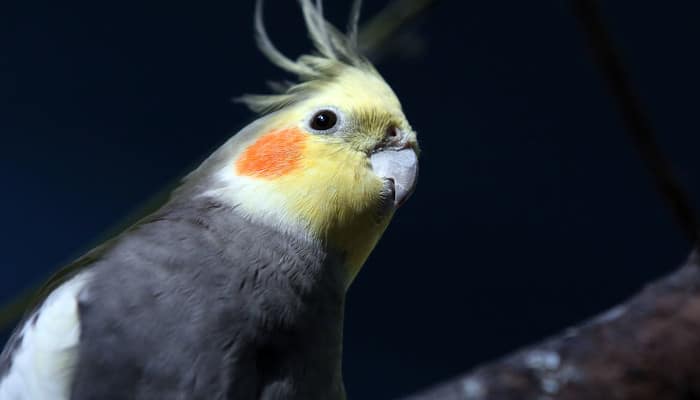It’s pretty common knowledge that cockatiels have excellent vision during the day but what about at night? Can cockatiels see in the dark? The answer is no, not really – not very well anyway. Their night vision is similar or slightly worse than that of humans.
Cockatiels are diurnal creatures. Diurnal is just a fancy word that means active during the day and inactive at night. Other examples of diurnal animals are dogs, squirrels, monkeys and of course, humans. All diurnal animals have good eyesight and vision during the day, but can’t really see well at night when it’s less important.
Coming back to cockatiels – In the wild, that means that during the day, cockatiels are awake, flying about, communicating with other cockatiels, foraging for food and avoiding predators. Their eyes are therefore adapted to seeing well during the day, but not at all adapted to seeing in the dark. As soon as the sun sets, cockatiels have trouble seeing predators. The can sort of see shadows and shapes and hear noises but they cannot see clearly. Realizing they are vulnerable to attack, they retire to holes in branches and tree trunks for protection and also to sleep. They stay there until dawn the next day.
That instinctive fear of predators at night explains why pet cockatiels often get scared at night. Those mini panic attacks are called night frights.
Cockatiel night frights
As mentioned above, in the wild, cockatiels will hide from predators at night because of their poor eyesight. They can hear other creatures moving around but they can’t see them. However since they are well hidden in holes in trees, they feel safe. They also usually have a bit of light from the moon so they are rarely in pitch black conditions.
That should help you understand why domesticated cockatiels can get scared at night. Night time = sleep time for cockatiels and they don’t like being disturbed by strange noises, strange people or even familiar people moving about. At night time, if you turn the lights off or even dim the lights and then continue moving around, making noise, you are going to scare your bird!
Your cockatiel can hear noises but all it can see is scary shapes and shadows moving around and it thinks there are predators out to get it. It will express its fear by hissing, flapping its wings and moving around erratically in its cage.
To calm your bird, speak to it gently to let it know it’s you until it calms down and then either leave it in peace by leaving the room and being silent or by putting on a dim light so your bird can see what’s going on again.
This is why it’s so important to have your cockatiel’s cage in a quiet place where people are not coming and going all the time. Don’t put the cage in a corridor or next to the bathroom. Cockatiels like to sleep at night and if their human is having a late night and making noise, it’s going to disturb them and frighten them.
Tips to help cockatiels in the dark
Stop moving their stuff!
Once you have decided on where to position the things in your cockatiel’s cage (perch, feeding bowls, water, toys), stick to it and don’t keep moving their stuff around. Even though they can’t see very well, if they know exactly where everything is, they will be able to find it by feel. If they can’t find their food or perch because you’ve moved it for the 10th time that month, they are even more likely to become scared and annoyed.
Put a dim light near their cage
Position a very dim light so that it gives them just enough light so as not to be scared but not too much light to keep them awake. In the wild, they have moonlight. Try to emulate that.
Interesting facts about cockatiels’ vision
Cockatiels’ eyes are positioned on the side of their heads. That gives them excellent peripheral vision. In fact they can see at almost 360° around them. That ability is what helps keep them safe from predators.
They have very limited binocular vision. This means they have trouble estimating the distance to objects. You can simulate what that feels like yourself with the following experiment:
- Sit at a table and place a pencil flat on the table within arm’s reach of you.
- Cover your left eye with your left hand.
- Position your right hand very close to you and at about 50cm above the table.
- Point your right index finger down like a down arrow.
- With your left eye still covered and using only your right eye, move your right finger backwards and stop when you judge it is above the pencil (still at a height of about 50cm)
- Move your finger down in a straight line until it touches the pencil or table.
What you will find is that it’s quite hard to judge the distance to the pencil even though you can see it very clearly. That is how cockatiels see!
Cockatiels’ eyeballs don’t move much within the socket. That is why they are constantly moving their heads.
Cockatiels can see more colors than humans because of their ability to see ultra-violet light.
Summary
Cockatiels don’t see very well at night because they are diurnal. They get scared of noises and movement at night – a phenomenon known as “night frights”.
I hope you found this article useful. Feel free to share a link to it on social media. 🙂








I thought this was a very big eye opener as I have 2 cocktails, and I found it very interesting, if possible I’m going to post on Facebook cheers ron